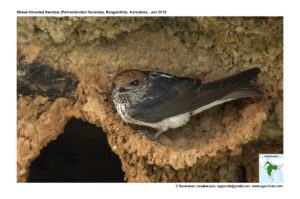Streak-throated Swallow

Streak-throated Swallow Petrochelidon fluvicola
Etymology:
- Petrochelidon : Greek word petros-rock; khelidon –swallow.
- Fluvicola : Latin word fluvii – river ; cola –dweller
Vernacular Names: Hindi: Nahar ababil, Pun: Nahiri ababil, Guj: Bhekhad ababil, Nanu tharodiyu, Mar: Reshal Kanthachi Bhingari
Distribution in India: Widespread resident except North, North West , North East and parts of southIndia.
Description: Size of 11–12 cm; wt. of 8–12 g. It has forehead, crown and nape dull as chestnut with faint dark streaks, back is glossy with deep blue and few narrow whitish streaks, rumpis pale brown; wings and tail are blackish-brown, tailis almost square-ended; underpartsare buffy white, blackish-brown streaks on, especially, chin, throat, neck side and breast; underwing-coverts are grey-brown. Both the sexes are alike. The juvenile is duller and browner than adult, with buff feather edges, faint streaks on underparts.
Habitat: It is found in open country, foothills, cultivation, and human habitations, including towns; often near water, including canals, rivers, and lakes.
Food habits: It eats flies. It forages in flocks; joins other swallow. The flight is weak and fluttery.
Breeding habits: They breeds in Mar–Jun in North India and Dec–Apr and Jul–Oct in South Indiaand Jul–Oct in Pakistan. They have two broods. They are colonial, a few tens to a few hundred pairs, nestsare found abutting each other, often in tiers. The nest is built by both sexes. The nest has a tubular entrance, made of mud pellets, lined with dry grass, horsehair and feathers, attached to cliff, bridge, culvert, irrigation barrage, or building; sites over water preferred. They lay a clutch of 3–4 eggs.Both sexes incubate and both feed nestlings.